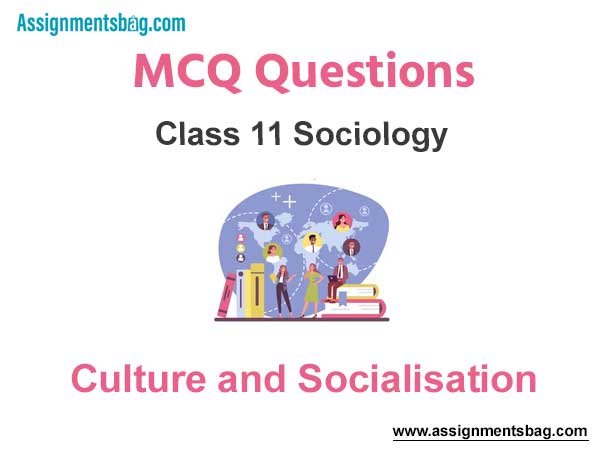Please refer to MCQ Questions Chapter 4 Culture and Socialisation Class 11 Sociology with answers provided below. These multiple-choice questions have been developed based on the latest NCERT book for class 11 Sociology issued for the current academic year. We have provided MCQ Questions for Class 11 Sociology for all chapters on our website. Students should learn the objective based questions for Chapter 4 Culture and Socialisation in Class 11 Sociology provided below to get more marks in exams.
Chapter 4 Culture and Socialisation MCQ Questions
Please refer to the following Chapter 4 Culture and Socialisation MCQ Questions Class 11 Sociology with solutions for all important topics in the chapter.
MCQ Questions Answers for Chapter 4 Culture and Socialisation Class 11 Sociology
Question. Which of the following terms was used by Ruth Benedict to characterize cultures that value restraint and modesty?
(a) Apollonian
(b) Dionysian
(c) Hellenic
(d) Athenian
Answer
A
Question. Which of the following terms was used by Ruth Benedict to characterize cultures that value excess and ostentatiousness?
(a) Apollonian
(b) Dionysian
(c) Hellenic
(d) Athenian
Answer
B
Question. Example of non-material culture is ______________
(a) Building
(b) Religion
(c) Pencil
(d) Cloth
Answer
B
Question. Psychoanalytical theory was developed by _________________
(a) Sigmund Freud
(b) Carl Jung
(c) Margaret Mead
(d) Ruth Benedict
Answer
A
Question. Movies are an example of
(a) High culture
(b) Low culture
(c) Popular culture
(d) Elite culture
Answer
C
Question. ___________________ is a person who is taken as the point of reference in a discussion.
(a) Individual.
(b) I
(c) Ego.
(d) Super ego.
Answer
D
Question. Who used the terms Apollonian and Dionysian to characterize cultures that value restraint and excess respectively?
(a) Franz Boas
(b) Edward Sapir
(c) Margaret Mead
(d) Ruth Benedict
Answer
D
Question. Which of the following is connected to the harshest punishment in any culture?
(a) Value
(b) More
(c) Folkway
(d) Taboo
Answer
D
Question. Organizations that produce popular culture are called
(a) Culture Industries
(b) Culture Makers
(c) Culture Machines
(d) Culture Companies
Answer
A
Question. The _______ is the idea that different cultures and ideas will blend together and create one ultimate culture or ide(a)
(a) mixture theory
(b) melting pot theory
(c) concoction theory
(d) assortment theory
Answer
B
Question. Sometimes we read news articles on foreigners who are attacked by local people. This is an example of
(a) Xenocentrism
(b) Xenophobia
(c) Xenography
(d) Xenophonia
Answer
B
Question. Inequalities in primitive societies are likely to be based on
(a) Caste
(b) Class
(c) Age
(d) Religion
Answer
C
Question. Assimilation contributes to the stability of society by
(a) minimizing group differences
(b) differentiating between groups
(c) compounding different groups
(d) expunging group differences
Answer
A
Question. When members of one group marry those of other social or ethnic groups it is known as
(a) Biological assimilation
(b) Physical assimilation
(c) Genetic assimilation
(d) Sub-cultural assimilation
Answer
A
Question. The work, ‘The Chrysanthemum and the Sword’ was written during
(a) The French Revolution
(b) War of the Roses
(c) First World War
(d) Second World War
Answer
D
Question. ‘The Chrysanthemum and the Sword’ is a famous study of a
(a) cultural difference
(b) cultural pattern
(c) cultural scheme
(d) none of the above
Answer
B
Question. Ruth Benedict was an anthropologist of _________ nationality.
(a) German
(b) British
(c) American
(d) French
Answer
B
Question. ‘The Chrysanthemum and the Sword’ was criticized because
(a) It used only primary sources of data
(b) It used only secondary sources of data
(c) It used only the interview method of data collection
(d) None of the above
Answer
B
Question. According to Ruth Benedict, cultures were ways of living, which she called _________
(a) cultural configurations
(b) cultural compounds
(c) cultural organizations
(d) cultural parties
Answer
A
Question. Which of the following books have been authored by Ruth Benedict?
(a) “The Mind of Primitive Man” and “Primitive Art”
(b) ‘Continuities in Cultural Evolution’ and ‘Culture and Commitment’
(c) ‘Primitive Culture’ and ‘Religion in Primitive Culture’
(d) ‘The Chrysanthemum and the Sword’ and ‘Patterns of Culture’
Answer
D
Question. Which of the following does not lead to diffusion?
(a) Exploration
(b) Tourism
(c) Immigration
(d) Suppression
Answer
D
Question. Discoveries can happen through
(a) Accident
(b) Scientific research
(c) Chance
(d) All of the above
Answer
D
Question. Which of the following is a downside of cultural relativism?
(a) It may be used to excuse rudebehaviour
(b) It may be used to excuse unscientificbehaviour
(c) It may be used to excuse behaviour that exploit human rights
(d) It may be used to excuse privileged behaviour
Answer
C
Question. Xenocentrism refers to
(a) Preference for the foreign
(b) Preference for ones own
(c) Preference for the familiar
(d) Preference for the imaginary
Answer
A
Question. Enculturation is closely related to
(a) Globalization
(b) Diffusion
(c) Assimilation
(d) Socialization
Answer
D

We hope you liked the above provided MCQ Questions Chapter 4 Culture and Socialisation Class 11 Sociology with solutions. If you have any questions please ask us in the comments box below.

